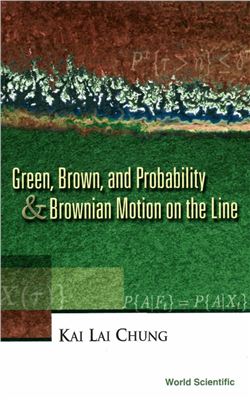World Scientific Publishing Company, 2002. - 200 pages.
Emphasizes the methodology of Brownian motion in the relatively simple case of one-dimensional space. Numerous exercises are included. For graduate students and researchers in probability and statistics.
In this exposition I hope to illustrate certain basic notions and methods of probability theory by unraveling them in a simple and fruitful case: that of the Brownian Motion Process
applied to a pair of famous problems in Electricity. One is the boundary value problem initiated by Green which begins this book, and the other is the equilibrium problem formerly associated with an energy principle, which concludes this book. The first problem is solved by the distribution of the Brownian paths at their first exit from Green's conductor, and the second
problem by that of the same paths at their last exit there-from. To adopt a classic Chinese rhetorical tu: "if one could what would Green resurrect and ask him" say?
The book is short enough not to require a summary or abstract. The undecided reader can easily leaf through the hundred generously spaced, well printed pages to see if he/she is "willing and able". To quote Emerson: "'Tis the good reader that makes the good book". In my writing I have taken a generally inquisitive, tutorial stance, interposed some amusing history and personal reminiscences, indulged in a few cavils and slangs, frequently taken the reader into my confidence,
with quizzing and teasing.
Emphasizes the methodology of Brownian motion in the relatively simple case of one-dimensional space. Numerous exercises are included. For graduate students and researchers in probability and statistics.
In this exposition I hope to illustrate certain basic notions and methods of probability theory by unraveling them in a simple and fruitful case: that of the Brownian Motion Process
applied to a pair of famous problems in Electricity. One is the boundary value problem initiated by Green which begins this book, and the other is the equilibrium problem formerly associated with an energy principle, which concludes this book. The first problem is solved by the distribution of the Brownian paths at their first exit from Green's conductor, and the second
problem by that of the same paths at their last exit there-from. To adopt a classic Chinese rhetorical tu: "if one could what would Green resurrect and ask him" say?
The book is short enough not to require a summary or abstract. The undecided reader can easily leaf through the hundred generously spaced, well printed pages to see if he/she is "willing and able". To quote Emerson: "'Tis the good reader that makes the good book". In my writing I have taken a generally inquisitive, tutorial stance, interposed some amusing history and personal reminiscences, indulged in a few cavils and slangs, frequently taken the reader into my confidence,
with quizzing and teasing.

